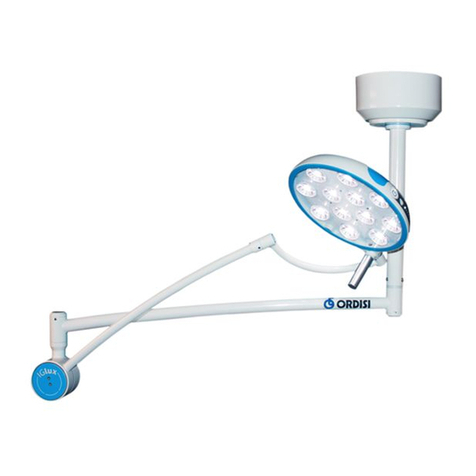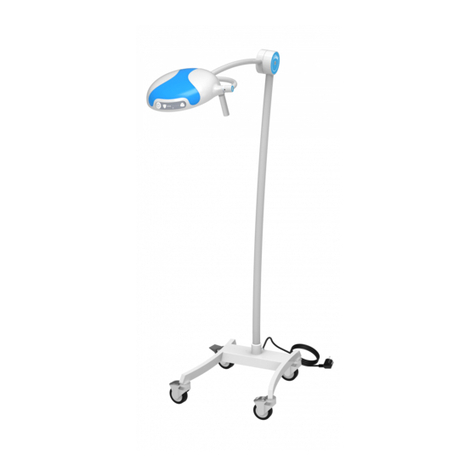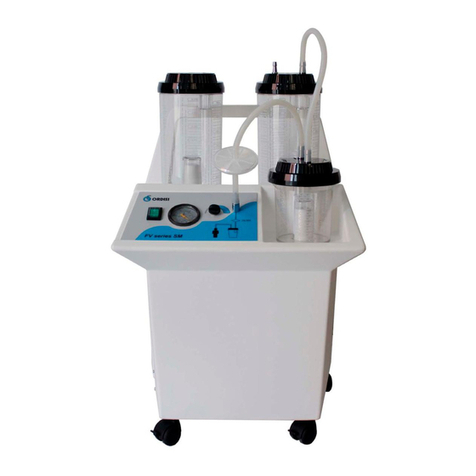Pág. 3 de 9
4.- INSTALLATION AND COMMISSIONING
4.1.- UNPACKING
Upon reception of the equipment, if package is seen as damaged, immediately check if device has been affected. If
damages are confirmed, immediately refer them to sender.
4.2.- COMMISIONING
Not to use in explosive atmospheres like the anesthetic produced ones by inflammable.
1) Check room electrical installation where equipment is tobe fitted it such installation meets IEC (UNE) standards
with a good earthing. Check voltage is same as show in the nameplate
2) Press ON/OFF light-switch Nº 1. Light-switch should now be lighted and device start its operation.
3) With the aspirator, you will find a aspiration set for a single use, (GRAVE RISK OF INFECTION IF USED IN
MANY PATIENTS) composed by 2 meters of suction tube, one probe, and connector. The union of the probe
and the suction tube, is through the grooving connector, by pressure. Connect the other extreme of the tube, in
the connector patient, as shown in the plug of the bottle Nº 3, and turn on the aspirator. To see point 2 section
4.3.
References for new orders
US0110020 3 meters suction tube (20 units)
US0214100 aspiration probe CH14 (100 units)
US1000020 conical connector (20 units)
FB-194A Bacterial filter
4) Through vacuum regulator control Nº 8, is possible to increase or to decrease vacuum level.
5) Vacuum gauge Nº 2 will show, at any time, the vacuum level being actually caused on the
patient.(tolerance±1.6%). It is recommended that in normal conditions, the calibration of the vacuum-gauge is
made once every two years.
4.3.- RECOMENDATIONS FOR USE
1) Avoid an excessive filling of the collection bottle (recommended not to fill more that 80% of his capacity),
a possible overflowing and penetration of liquid in the pump interior will thus be prevented. In this case, we
advise you to remove the pump lathe head for to clean it, by an Authorized Technical Service.
2) Excessively large suction tubes should never be used, because they have a trend to nipping and any
subsequent collapse will cause a suction choking. On the other hand, a risk is run that elbows are made up
wherein aspirated fluids can be settled originating therefore a possible infection and pollution centre.
Periodically replace the tube of aspiration by a specific tube for this one assignment (it must take to noticeable
CE of conformity fulfilling the norm UNE EN 1617 of drainage tubes). Verify when replacing these and before
coming to the
We recommended the use of the following tubes of aspiration:
-PVC tube minimum inner diameter 6 mm by 9 mm of outer diameter.
-Silicone tube minimum inner diameter 6 mm by 10 mm of outer diameter.
3) Avoid patient resting on the suction tubes in a way that suction might be choked.
4) Clean and sterilize the top Nº 5, the safety valve Nº 6 and the bottle, after of each use.
5) Never run the aspirator if a vacuum is detected in the circuit, previously have vacuum level decreased to 0.
6) This equipment have not been designed for continuous drainage. Do not use it for this purpose.
7) Is advisable to use an antifoaming for to avoid that the accumulation of foaming in the bottle, covers the filling
level.
8) Never connect any mechanism nor arrangement (as ventilators, aerosol generators, etc.) to the air outlet.
9) In case of excessive filling of bottle and if take the safety valve Nº 6, the aspirator don’t work. To stop the
equipment with the switch, decreased the vacuum level to 0 with the vacuum regulator Nº 8 and to change or to
empty the bottle.
10) The biological risk waste will be removed following the protocol of the hospital waste management





























